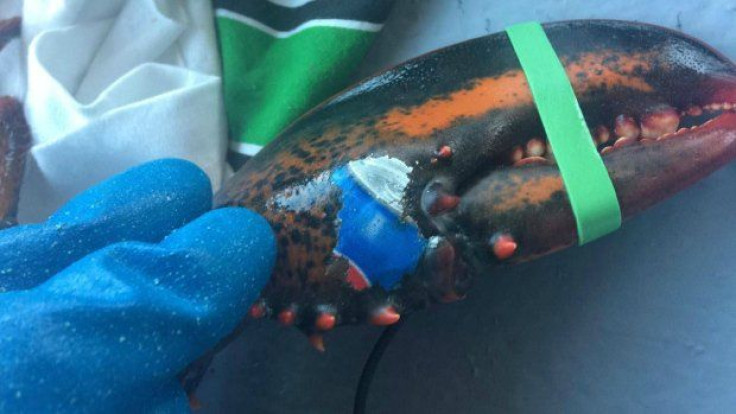Lobster Found Tattooed With Pepsi Design On Claw

A lobster fisher relayed a sad message about the effect of humans polluting the environment when she took a photo of a lobster claw that had a Pepsi can design imprinted on its claw like a tattoo.
Karissa Lindstrand shared the image with CBC, taken off Grand Manan Island in New Brunswick while she was banding lobster claws. The island is located where the Bay of Fundy meets the Gulf of Maine, right at the border of Canada and the United States.
“They believe that maybe there was a can in the bottom of the ocean and when [the lobster] was growing, it grew around the can,” Lindstrand told CBC. An alternative theory is that the design came not from a can, but from a Pepsi box. “This tells me there is a lot of garbage in the ocean, if that's what's happening to the lobsters we get out from the water.”
In a blog post on its website, the nonprofit Conservation Council of New Brunswick called this kind of garbage “a dishearteningly common and pervasive problem in our oceans.”
While this unfortunate lobster may have encountered an aluminum can, plastic pollution has been a particularly alarming issue around the world. Matt Abbott, the baykeeper for Fundy, told CBC that plastic breaks down into smaller pieces and can be dangerous to animals that may eat them.
Our @FundyBaykeeper talks about the disheartening #PepsiLobster catch today on @CBCMaritimeNoon #nb #marinedebris #plasticpollution #nbwater #bayoffundy #grandmanan https://t.co/0IInRgu9Es
According to the council, Abbott’s position involves cleaning up “large debris from the water and coastline.”
In recent years, scientists have found plastic pollution to be so pervasive that there are giant blobs of discarded plastic bottles and other waste, including bags of blood, floating in the ocean like islands. And the most remote landmass in the world, the uninhabited Henderson Island in the South Pacific Ocean, has become the most densely littered place on the planet. Scientists who recorded the amount of waste that had washed up on the island’s shore found an average of a few hundred pieces of debris for each square meter of beach, not including the thousands more that were buried in the first 10 centimeters of sand below the surface. They estimated that there were 37.7 million total pieces of debris on the beach in those top 10 centimeters, with more coming in all the time with the tides.
Between four million and 12 million tons of plastic enter the world’s oceans each year, according to previous research.
“Plastic debris is an entanglement and ingestion hazard for many species, creates a physical barrier on beaches to animals such as sea turtles and lowers the diversity of shoreline invertebrates,” Henderson Island pollution researcher Jennifer Lavers said at the time the estimates were released. “What’s happened on Henderson Island shows there’s no escaping plastic pollution even in the most distant parts of our oceans.”
New Brunswick fisherman finds lobster with Pepsi can imprinted on claw https://t.co/IzIwAWtG10 pic.twitter.com/Cy7FC1Z9oH
— CBC Newfoundland and Labrador (@CBCNL) November 29, 2017
© Copyright IBTimes 2024. All rights reserved.











